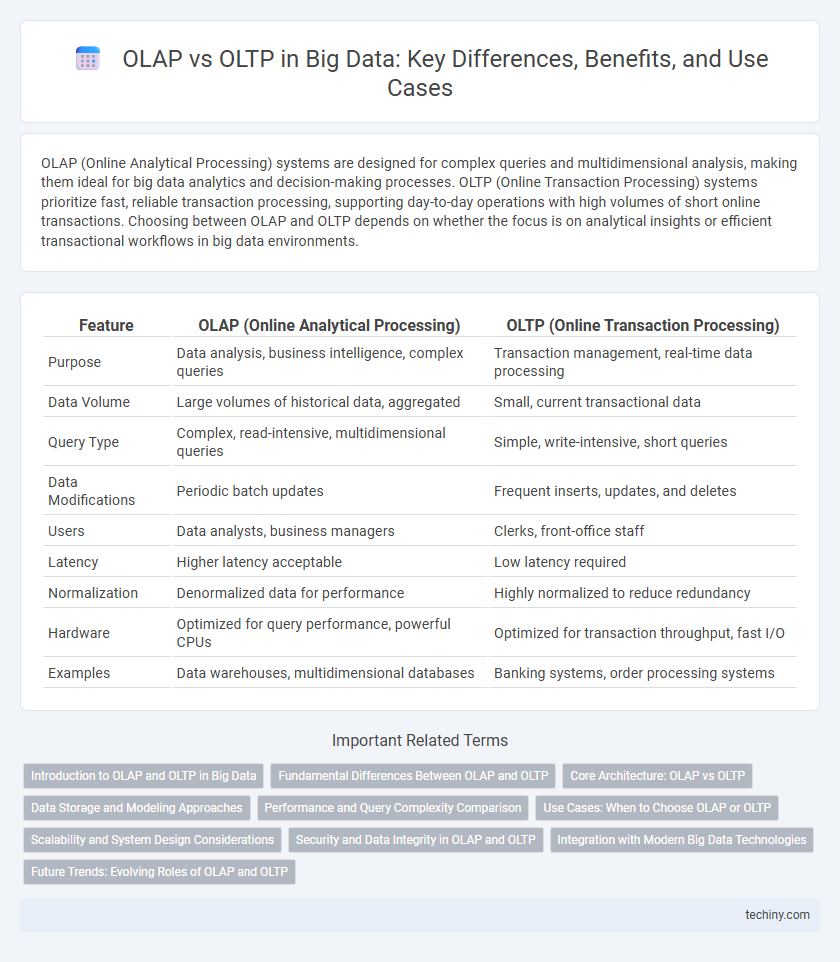OLAP (Online Analytical Processing) systems are designed for complex queries and multidimensional analysis, making them ideal for big data analytics and decision-making processes. OLTP (Online Transaction Processing) systems prioritize fast, reliable transaction processing, supporting day-to-day operations with high volumes of short online transactions. Choosing between OLAP and OLTP depends on whether the focus is on analytical insights or efficient transactional workflows in big data environments.
Table of Comparison
| Feature | OLAP (Online Analytical Processing) | OLTP (Online Transaction Processing) |
|---|---|---|
| Purpose | Data analysis, business intelligence, complex queries | Transaction management, real-time data processing |
| Data Volume | Large volumes of historical data, aggregated | Small, current transactional data |
| Query Type | Complex, read-intensive, multidimensional queries | Simple, write-intensive, short queries |
| Data Modifications | Periodic batch updates | Frequent inserts, updates, and deletes |
| Users | Data analysts, business managers | Clerks, front-office staff |
| Latency | Higher latency acceptable | Low latency required |
| Normalization | Denormalized data for performance | Highly normalized to reduce redundancy |
| Hardware | Optimized for query performance, powerful CPUs | Optimized for transaction throughput, fast I/O |
| Examples | Data warehouses, multidimensional databases | Banking systems, order processing systems |
Introduction to OLAP and OLTP in Big Data
OLAP (Online Analytical Processing) in Big Data enables complex queries and multidimensional analysis for strategic decision-making, handling large volumes of aggregated historical data. OLTP (Online Transaction Processing) focuses on real-time transaction management, supporting high-volume, day-to-day operations with rapid query processing and data integrity. Both OLAP and OLTP systems are integral to Big Data architectures, optimizing data storage, retrieval, and analysis for business intelligence and operational efficiency.
Fundamental Differences Between OLAP and OLTP
OLAP systems are designed for complex queries and data analysis, supporting decision-making processes by enabling multidimensional data exploration and aggregation, whereas OLTP systems prioritize high-volume transaction processing with real-time insert, update, and delete operations. OLAP databases typically involve historical data stored in data warehouses optimized for read-intensive queries, while OLTP systems manage current operational data with a focus on data integrity and fast transaction processing. The fundamental difference lies in OLAP's analytical workload optimized for querying large datasets and OLTP's transactional workload optimized for daily business operations.
Core Architecture: OLAP vs OLTP
OLAP systems utilize a multidimensional data model optimized for complex queries and analytical processing, often deployed in data warehouses with star or snowflake schemas. OLTP architectures are based on highly normalized relational databases designed for fast transaction processing and real-time data integrity. The core distinction lies in OLAP's focus on read-heavy analytical workloads versus OLTP's emphasis on write-heavy transactional operations with ACID compliance.
Data Storage and Modeling Approaches
OLAP systems employ multidimensional data storage and star or snowflake schema modeling to optimize complex analytical queries and data aggregation across large datasets. OLTP systems utilize highly normalized relational databases designed for efficient transaction processing and real-time data integrity, focusing on fast insert, update, and delete operations. Data modeling in OLAP emphasizes denormalization to improve query performance, while OLTP prioritizes normalization to minimize data redundancy and maintain consistency.
Performance and Query Complexity Comparison
OLAP systems are optimized for complex queries involving large volumes of data, enabling multi-dimensional analysis and aggregations with high performance on read-intensive workloads. OLTP systems prioritize transaction speed and data integrity, handling numerous simple, write-heavy operations with minimal latency. The performance difference lies in OLAP's ability to efficiently process complex queries over massive datasets, while OLTP excels in fast query execution on transactional data with lower computational complexity.
Use Cases: When to Choose OLAP or OLTP
OLAP is ideal for complex queries involving large datasets, supporting business intelligence tasks such as sales forecasting, market trend analysis, and financial reporting. OLTP systems excel in managing daily transaction processing, including order entry, payment processing, and inventory management requiring fast query performance and data integrity. Choose OLAP for analytical workloads and decision-making processes, while OLTP suits real-time transactional operations with high concurrency.
Scalability and System Design Considerations
OLAP systems prioritize scalability by supporting complex queries on large, historical datasets using multidimensional data models optimized for read-intensive operations. OLTP systems focus on high throughput and low latency for transaction processing, requiring designs that ensure data integrity and support rapid, concurrent updates with normalized schemas. System design for OLAP often leverages distributed storage and parallel processing, whereas OLTP emphasizes ACID compliance and real-time responsiveness through optimized indexing and locking mechanisms.
Security and Data Integrity in OLAP and OLTP
OLTP systems prioritize security and data integrity through real-time transaction processing with strict ACID (Atomicity, Consistency, Isolation, Durability) compliance, ensuring safe and accurate updates in high-concurrency environments. OLAP systems, designed for complex analytical queries and large data aggregations, implement security measures such as role-based access controls and data encryption but focus less on immediate transactional integrity. Ensuring data integrity in OLAP relies on controlled data refresh processes and validation protocols to maintain consistency across massive datasets for reliable decision-making.
Integration with Modern Big Data Technologies
OLAP systems enable complex analytical queries on multidimensional data sets, integrating seamlessly with big data technologies like Apache Hadoop and Spark for scalable, high-performance data warehousing and analytics. OLTP systems prioritize real-time transaction processing, leveraging modern NoSQL databases such as MongoDB and Cassandra to handle high-velocity, concurrent data operations efficiently. Both OLAP and OLTP architectures incorporate cloud-native solutions and data lakes to enhance data integration, governance, and accessibility in big data environments.
Future Trends: Evolving Roles of OLAP and OLTP
OLAP systems are increasingly integrating machine learning algorithms to enhance real-time analytical insights, enabling predictive analytics on vast data lakes. OLTP platforms are evolving with blockchain technology to secure and streamline high-frequency transactional operations, supporting growing demands in financial and healthcare sectors. The convergence of OLAP and OLTP through hybrid transactional/analytical processing (HTAP) architectures is driving faster decision-making by combining real-time transactional data with deep analytical querying capabilities.
OLAP (Online Analytical Processing) vs OLTP (Online Transaction Processing) Infographic

 techiny.com
techiny.com